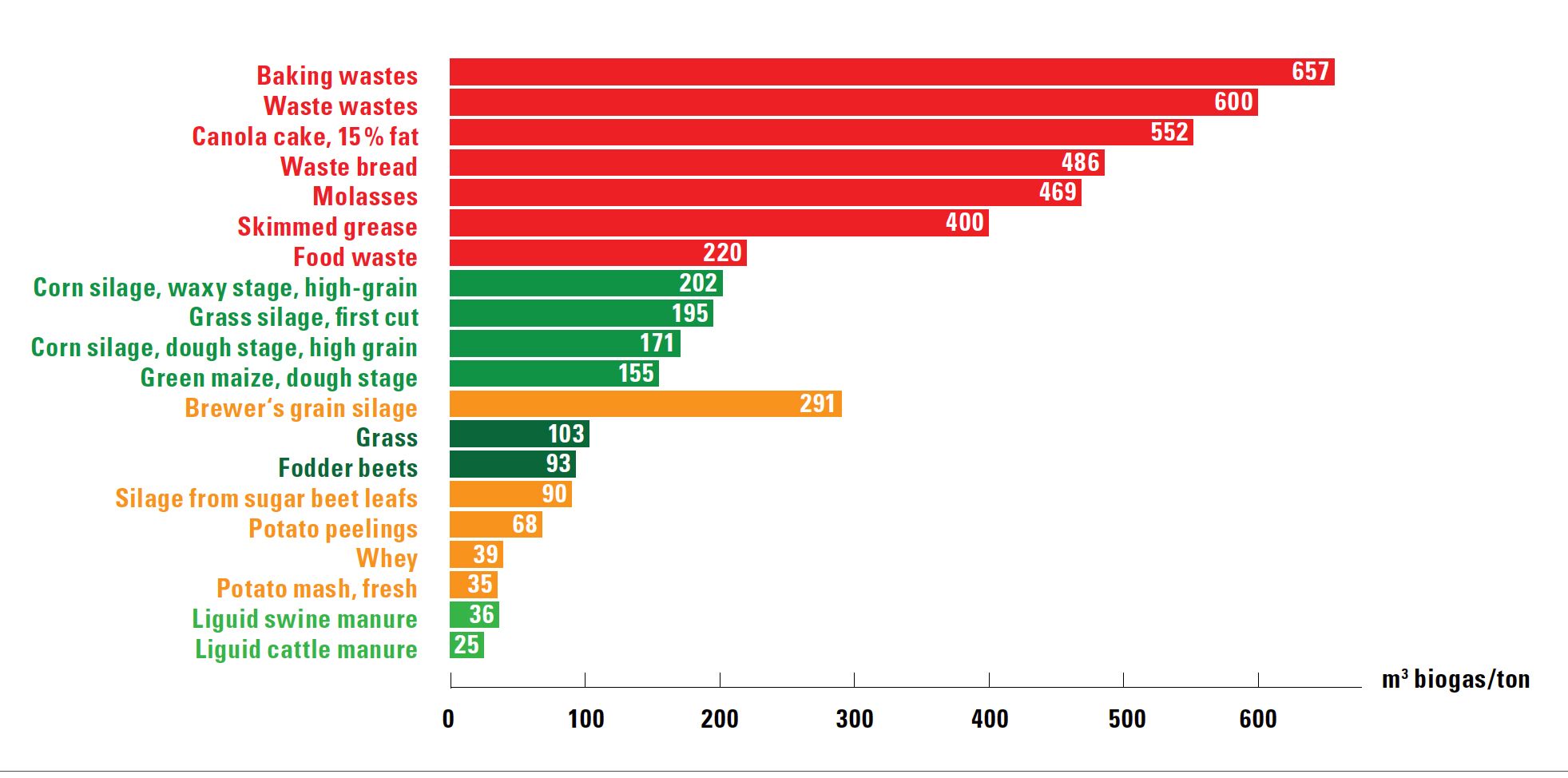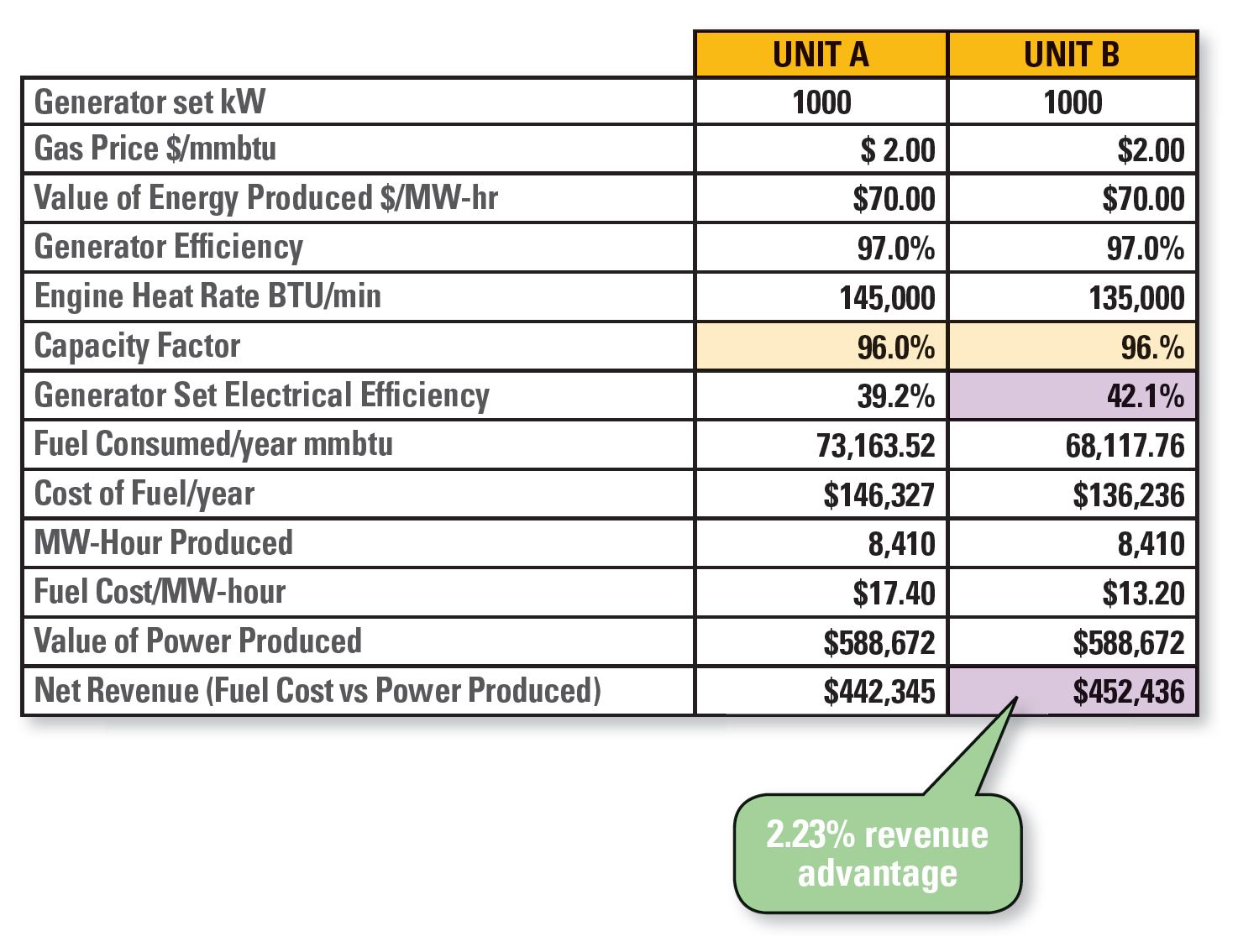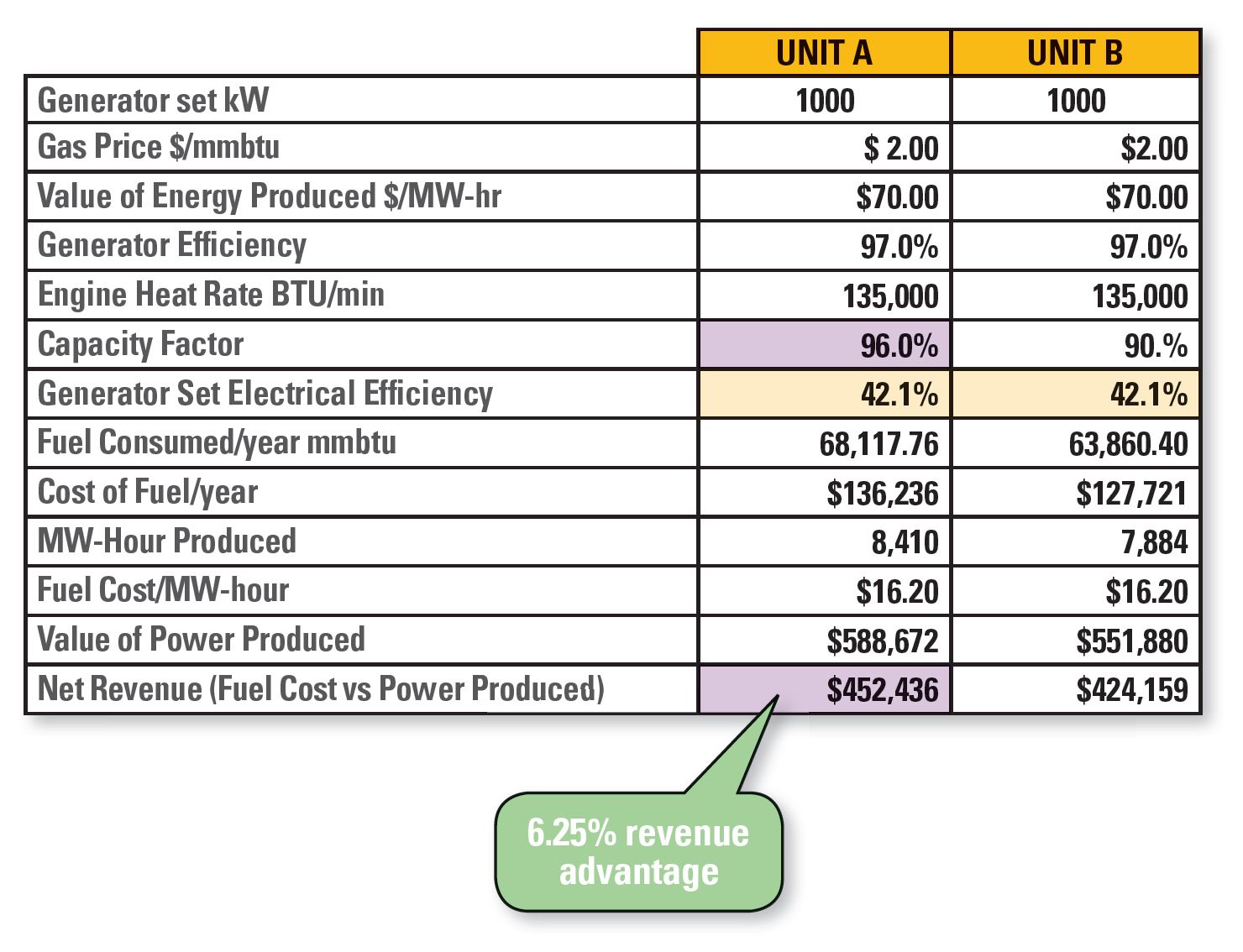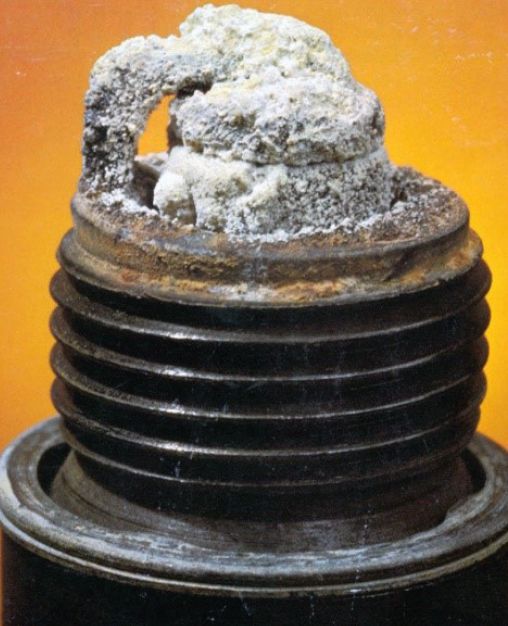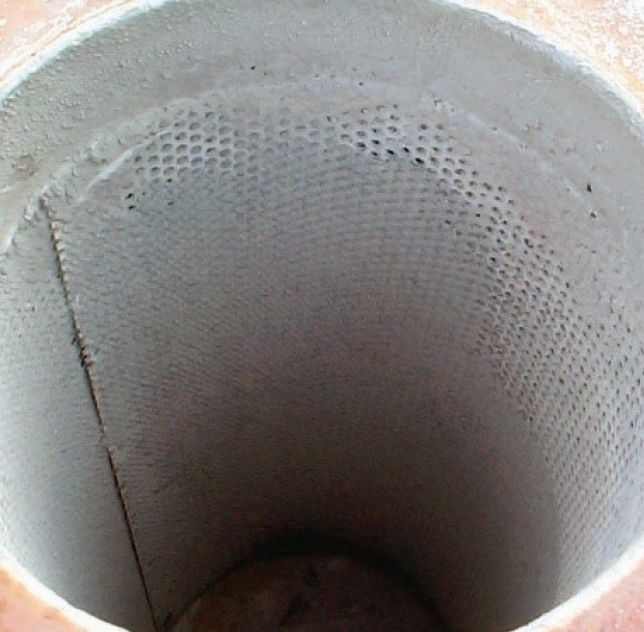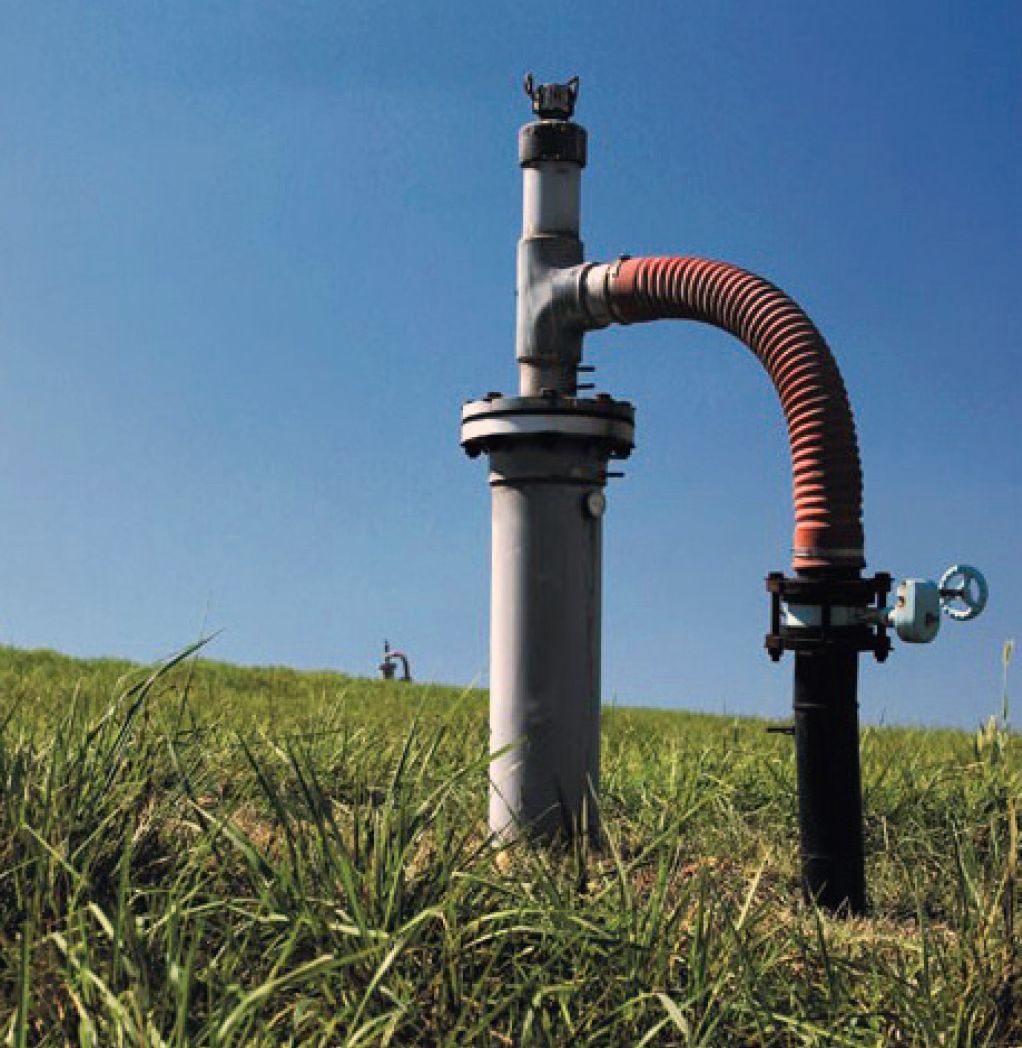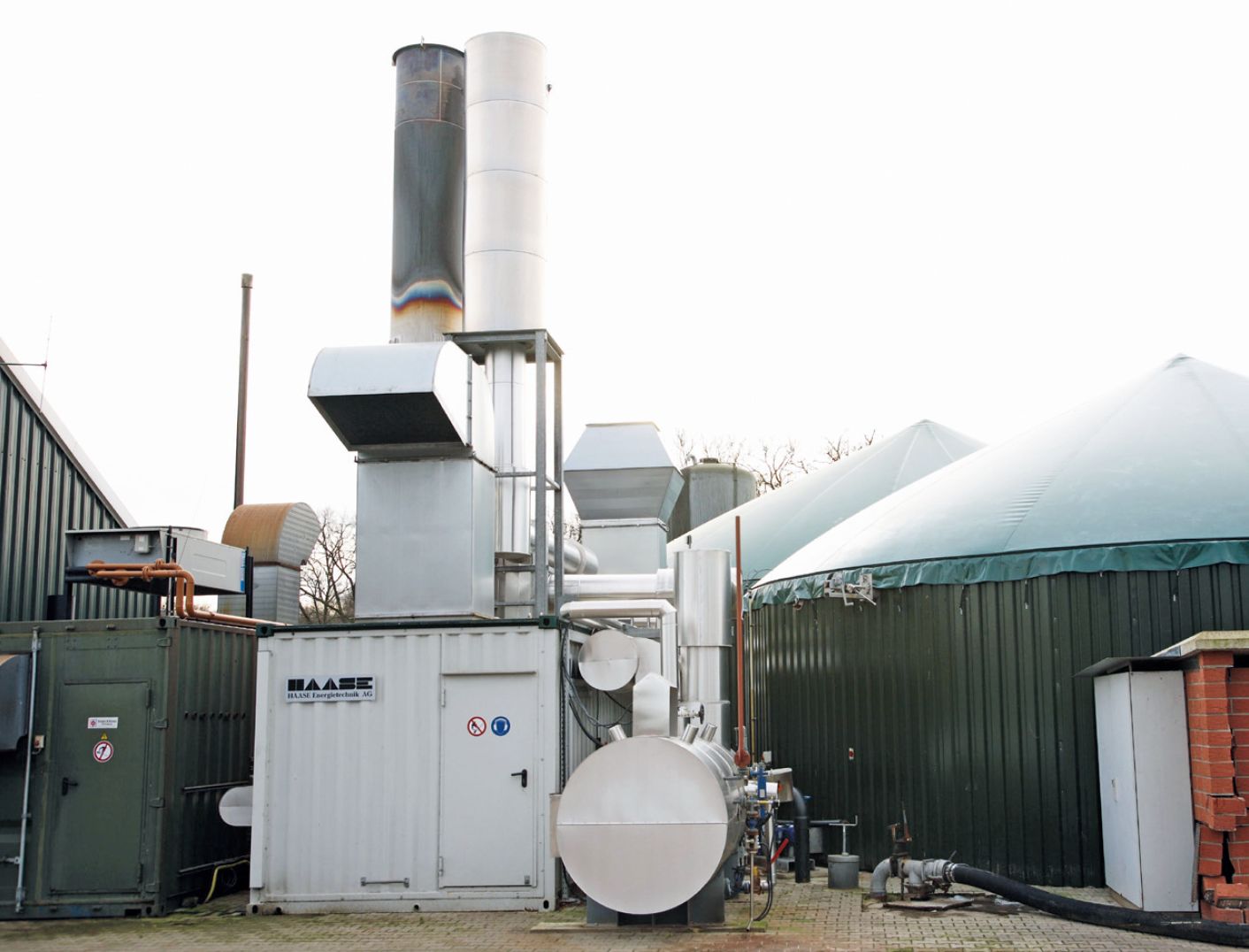A variety of industries can potentially benefit from biogas-to-energy projects. Feedstocks for anaerobic digesters can include silage from energy crops like corn and sweet sorghum, crop residues, green cuttings from landscape maintenance, food waste from restaurants and cafeterias, fats and oils, and wastes from food and beverage facilities like breweries, sugar plants, fruit and vegetable processors, and meat processing plants. Animal waste alone is among the lowest biogas producers – the recipe can be improved by co-digesting with fats and oils or vegetative material (Figure 1).
Revenue side
The analysis of benefits begins with estimating revenue. The base calculation assumes an estimated fuel flow and fuel quality, and an engine-generator of a given capacity operated continuously for one year. For example, a 20-cylinder generator set rated at 2,000 kW can generate $112 per hour based on an electricity sale price of $0.056 per kWh. Based on 8,760 hours per year, that unit theoretically could generate $981,120 in revenue annually.
Of course, no generator can operate around the clock for a year. Real revenue is determined by the theoretical revenue multiplied by capacity factor – the percent of its total potential output the units actually achieves. The key items that affect capacity factor and revenue are:
- Availability. Revenue is lost anytime the generator does not operate. This includes downtime for maintenance and repairs. Unavailable periods also include any times when the digester is not producing gas.
- Load factor. Revenue is lost if the generator is unable to operate at full load. That can happen if the fuel supply is temporarily limited, or if fuel quality declines.
- Derates. High temperature and high altitude could keep the generator set from achieving its nameplate capacity rating.
It is also important to understand how tradeoffs between generator set capacity factor and generator set electrical efficiency affect revenue. Assume two 1,000 kW units, an electricity sale price of $70 per MWh, and a fuel production cost of $2/MMBtu ($70.63 /Nm³). Now assume that both units operate at 96 percent capacity, but that Unit A is 39 percent efficient while Unit B is 42 percent efficient. In that scenario, Unit B has a 2.2 percent net revenue advantage (Figure 2).
Now for the same two units, assume that electrical efficiency is the same at 42 percent, but that Unit A’s capacity factor is 90 percent and Unit B’s is 96 percent. In this scenario, Unit B has a 6.25 percent revenue advantage (Figure 3).
Expense Side
Owning and operating expenses fall on the opposite side of the ledger, usually measured in cost per kilowatt-hour sold or produced. The kilowatt-hour figure needs to account for conditions that reduce generator output: Parasitic loads, capacity factor, derates, and others.
In biogas applications, the major expenses are capital costs (including fuel treatment) and maintenance and repairs. The latter includes routine engine maintenance as well as periodic top-end, in-frame and major overhauls. Maintenance practices should not follow a fixed calendar schedule, but should be based on predictive indicators. Predictive maintenance can help extend service and overhaul intervals and reduce service costs by up to 15 percent. Good predictive practices include:
- Using oil analysis to change oil when it truly needs changing – not at a prescribed run-time interval. While oil oxidation and nitration determine oil condemning limits in pipeline-gas-fueled applications, those limits in biogas applications relate to low total base number (TBN), which measures the amount of acid-buffering capacity remaining in the oil, and high total acid number (TAN ), the amount of acid present.
- Monitoring trends like valve recession, oil consumption and exhaust emissions to fine-tune overhaul schedules.
- Using tools like vibration analysis and infrared thermography to detect potential trouble before failures happen.
Caring for Fuel
The biggest variable affecting biogas project costs is fuel quality. Depending on its source, biogas contains a variety of impurities that can increase wear and shorten maintenance and service intervals. These impurities include:
- Hydrogen sulfide (found in most biogas) and halogenated hydrocarbons (most common in landfill and wastewater treatment digester gas) can combine with water to form acids that erode engine components.
- Silicon (dust, sand, grit), found in most biogas, causes premature abrasive wear.
- Siloxanes (silicon compounds from household products found in landfill and wastewater digester gas) form hard, ceramic-like deposits on cylinder components (Figure 4-8).
- Water. Engines are typically designed to operate at up to 80 percent relative humidity as measured by non-condensing water in the fuel; most biogases exceed that level significantly.
There are three basic ways to deal with fuel impurities. They can be used alone or in combination, depending on the fuel quality, ambient conditions, financial objectives and other considerations.
1. Treat the fuel
Various technologies can remove significant amounts of fuel impurities. For example:
- A chiller, demister or coalescing filter effectively removes water from the fuel.
- Siloxanes can be captured by adsorbents such as charcoal and silica gel.
- Air filtration is effective against silicon (dust/dirt) and other particulates.
- Activated carbon adsorbent removes hydrogen sulfide.
While effective at reducing contaminants in the fuel, fuel treatments do add to biogas-to-energy system capital costs, add parasitic loads to the system, and require additional maintenance materials and labor.
2. Choose a ‘hardened’ engine
Some manufacturers offer engines with design features that “harden” components and systems against biogas fuel impurities. These units can operate for near-normal maintenance intervals with less intensive fuel treatment. Such modifications include:
- Crankcase ventilation – As an added line of defense against corrosion, a low-pressure pump ejects blowby gases from the crankcase and draws in warm, fresh, filtered air, so that crankcase components are not exposed to acid-forming gases and water vapor.
- Cooling system changes – Elevated jacket water temperature – 230°F (110°C) versus traditional 210°F (99°C) helps prevent condensation of water, which attracts the sulfur, chlorine and fluorine entrained in the fuel to form weak yet damaging acids. Specifically, the higher temperature keeps water in the fuel entering the engine from condensing on the cylinder liners, and keeps crankcase ventilation gases from condensing on the engine block and other components, potentially carrying acids into the lube oil. Tests have shown show that the higher jacket water temperature significantly reduces cylinder liner pitting and acid corrosion of cylinder components, crankshafts, bearings and other wear parts. Limiting the condensation of exhaust gases also increases oil life by reducing the acids that must be absorbed by the base (alkaline) elements in the oil.
- Material changes – Bright metals (aluminum and unprotected steel) that are vulnerable to acid corrosion are replaced in certain components. For example, aftercooler cores made from aluminum in standard engines are made of stainless steel in biogas versions; connecting rod bearing use brass backing instead of steel.
- Component geometry changes – Special modifications help limit the effects of fuel siloxanes. For example, valve and valve seat angles are increased to prevent formation of hard deposits that could prevent proper value closure, allowing combustion gases to escape, cause burned exhaust valves, and erode engine performance
3. Accelerate maintenance
In some cases, it may be more attractive to owners to defer on the installation costs associated with advanced fuel treatment systems, and accept the operating costs associated with shorter maintenance and overhaul intervals. This ‘pay me now or pay me later’ dilemma is often decided based on a developer’s assessment of risk and reward.
Evaluating Tradeoffs
Dealing with fuel impurities means weighing the pros and cons of different engine technologies, fuel treatment systems and their initial and long-term costs. For example, if the fuel quality falls within the limits prescribed for hardened low-energy-fuel engines, then that engine can be used with minimal or no fuel treatment equipment, likely saving hundreds of thousands of dollars in capital and fuel treatment operating costs.
On the other hand, if the fuel impurities are such that extensive pretreatment is required regardless of the engine technology, then high-compression/high efficiency engines may be a prudent choice, as operating savings from the efficiency gains will help offset the costs of installing, operating, and maintaining the treatment system. Every project is different, and approached to fuel impurities must be weighed on a fuel- and site-specific basis.
Knowing the Gas
In choosing a strategy for dealing with impurities, there is no single right answer. The best approach for a given site depends on operating conditions, financial objectives and, above all, on biogas quality. Fuel needs to be analyzed over time to understand the levels impurities, the methane content and heating value, and how much those parameters vary over time – hourly, daily or seasonally. Trending of all these is important.
It is common for biogas originating from anaerobic digestion to contain about 60 percent methane, 35 percent carbon dioxide, and the balance other gases. It is critical to understand the volumetric energy content in the fuel is critical. For example, a lower-quality biogas with just 30 percent methane content means doubling the gas flow to deliver the same energy – and exposing the engine to twice the amounts of impurities. In addition, the fuel low heating value – the actual Btu/ft3 (MJ/Nm³) – influences the size of the fuel delivery system.
The fuel’s carbon dioxide content is also critical. Carbon dioxide affects flame speed in the cylinders, and the temperature must fall below a certain maximum level to keep exhaust and valve temperatures in a safe operating range and minimize maintenance. Another key variable is the ratio of methane to free inert gases, including carbon dioxide and free nitrogen (nitrogen not entering naturally from air in the fuel). Excessive inert gas content hinders fuel ignition, causing lean misfire and resulting in a loss of power and increased in exhaust emissions.
Siloxane content is a critical variable primarily in landfill and wastewater treatment plant biogas fuels. High-compressionratio engines are often preferred in biogas applications for their greater efficiency, but they are also less tolerant of siloxane contamination. Sites using high-compression-ratio engines may have no choice but to add fuel siloxane treatment, and its initial cost and ongoing maintenance needs to be considered in the project financial profile.
The project plan requires an estimate of maintenance costs in dollars per kilowatt-hour, both with fuel treatment and without. Ideally, a project evaluation looking at different levels of fuel treatment will provide enough insight into the probable costs of the project to guide the choice of the best investment alternative.
Chosing a Partner
Few organizations have the in-house expertise to plan and implement biogas-to-energy projects. Equipment suppliers and consultants can provide vital support from project planning through design, financing, construction, operation and maintenance.
An appropriate project partner should have a deep understanding of biogas and power generation and a track record for completing profitable projects. The partner should also have direct access to the most appropriate generation and fuel treatment technologies, as required by fuel and site conditions.
Locally-based maintenance, service and technical support is essential, as biogas projects can pose operating challenges. Fast service response time, prompt spare parts delivery, and efficient repair and overhaul services are essential to protecting uptime and keeping project revenue flowing.
The ideal partner offers single-source support for every project phase, including turnkey ability to design, construct and operate the project. One attractive option is to enter a complete, multi-year maintenance and service contract with an equipment supplier. This arrangement ensures attentive parts, maintenance and repair service with a contractual uptime guarantee, at a fixed, predictable monthly or annual fee.
The financing aspect is a critical component of any biogasto-energy project. Numerous options are available, including construction and term debit financing for the entire project – anaerobic digester, fuel treatment, power generation system, electrical switchgear and controls, ancillary equipment and buildings.
Getting started
Biogas is now recognized as a valuable renewable fuel. Besides creating a new source of revenue, a biogas project can help further corporate commitments to carbon footprint reduction and sustainable operations. Businesses with potential to produce and use biogas are wise to explore the possibilities in detail.
Specific Applications
Here are four examples of profi table biogas-to-energy operations using different fuel sources:
Landfill
The 74-acre (30 ha) landfi ll in Ämmässuo, Finland, operates four generator sets sourced from MWM GmbH, a Caterpillar company, each rated at 3.75 MW and burning landfi ll methane. The fuel’s low calorific value and low gas pressure (1.5 psi/10.34 kPa) required one gas train for each cylinder bank to provide enough fuel to achieve the rated output. The installation was commissioned in 2010.
Brewery
A biogas-fueled combined heat and power plant at the Guangzhou Zhujiang Brewery Group Co. in China accommodates seasonally variable load conditions. The system uses a Cat® G3508 generator set rated at 460 kW, and a Cat G3516 unit rated at 960 kW. The two units operate on biogas produced from grain and yeast byproducts. The overall effi ciency of the system is up to 80 percent. Cost savings from the system are estimated at more than US$58,000 (RMB400,000) per month.
Agriculture
A 600 kW Cat CG-132 generator set operated by hog producer Oude Lenferink in the Netherlands operates on methane produced from manure, maize and glycerin. The biogas engine, in service since 2007, provides more than enough power for the entire operation; excess electricity is fed to the utility grid and sold as green power.
Wastewater treatment
The Encina (Calif.) Water Pollution Control Facility uses biogas from its anaerobic digester to fuel four Cat G3516 generator sets rated at a combined 3260 kW. On a typical day, the generator sets run mostly on the biofuel; one operates on natural gas for four to eight hours per day during peak rate times. Online since 2009, the system generates 12 million kWh per year, meeting about 71 percent of the Encina Wastewater Authority’s needs. The agency’s plan calls for the wastewater facility to produce 96 percent of its energy needs on site by 2020.


